Signaling Pathways
The antibody-drug conjugate (ADC), a humanized or human monoclonal antibody conjugated with highly cytotoxic small molecules (payloads) through chemical linkers, is a novel therapeutic format and has great potential to make a paradigm shift in cancer chemotherapy. The three components of the ADC together give rise to a powerful oncolytic agent capable of delivering normally intolerable cytotoxins directly to cancer cells, which then internalize and release the cell-destroying drugs. At present, two ADCs, Adcetris and Kadcyla, have received regulatory approval with >40 others in clinical development.
ADCs are administered intravenously in order to prevent the mAb from being destroyed by gastric acids and proteolytic enzymes. The mAb component of the ADC enables it to circulate in the bloodstream until it finds and binds to tumor-specific cell surface antigens present on target cancer cells. Linker chemistry is an important determinant of the safety, specificity, potency and activity of ADCs. Linkers are designed to be stable in the blood stream (to conform to the increased circulation time of mAbs) and labile at the cancer site to allow rapid release of the cytotoxic drug. First generation ADCs made use of early cytotoxins such as the anthracycline, doxorubicin or the anti-metabolite/antifolate agent, methotrexate. Current cytotoxins have far greater potency and can be divided into three main groups: auristatins, maytansines and calicheamicins.
The development of site-specific conjugation methodologies for constructing homogeneous ADCs is an especially promising path to improving ADC design, which will open the way for novel cancer therapeutics.
References:
[1] Tsuchikama K, et al. Protein Cell. 2016 Oct 14. DOI:10.1007/s13238-016-0323-0.
[2] Peters C, et al. Biosci Rep. 2015 Jun 12;35(4). pii: e00225. doi: 10.1042/BSR20150089.
Ziele für Signaling Pathways
- Proteases(29)
- Apoptosis(864)
- Chromatin/Epigenetics(15)
- Metabolism(336)
- MAPK Signaling(26)
- Tyrosine Kinase(73)
- DNA Damage/DNA Repair(49)
- PI3K/Akt/mTOR Signaling(38)
- Microbiology & Virology(42)
- Cell Cycle/Checkpoint(166)
- Ubiquitination/ Proteasome(24)
- JAK/STAT Signaling(10)
- TGF-β / Smad Signaling(22)
- Angiogenesis(59)
- GPCR/G protein(3)
- Stem Cell(19)
- Membrane Transporter/Ion Channel(161)
- Cancer Biology(366)
- Endocrinology and Hormones(127)
- Neuroscience(366)
- Obesity, Appetite Control & Diabetes(8)
- Peptide Inhibitors and Substrate(1)
- Other Signal Transduction(96)
- Immunology/Inflammation(909)
- Cardiovascular(59)
- Vitamin D Related(0)
- Antibody-drug Conjugate/ADC Related(0)
- PROTAC(212)
- Ox Stress Reagents(24)
- Others(4058)
- Antiparasitics(6)
- Toxins(62)
Produkte für Signaling Pathways
- Bestell-Nr. Artikelname Informationen
-
GC63267
α-Chaconine
α-Chaconin hemmt die Expression von COX-2, IL-1β, IL-6 und TNF-α auf Transkriptionsebene.
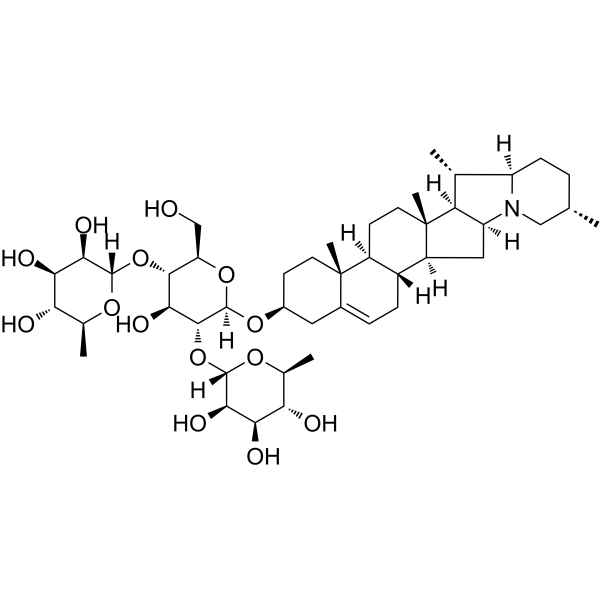
-
GC66197
α-?Terpinyl acetate
α-Terpinylacetat ist ein Monoterpenester, der aus dem Ätherischen Öl von Laurus nobilis L. isoliert wird. α-Terpinylacetat ist ein kompetitives P450 2B6-Substrat, das mit einem Kd-Wert von 5,4&7#956 an das aktive Zentrum von P450 2B6 bindet;M.
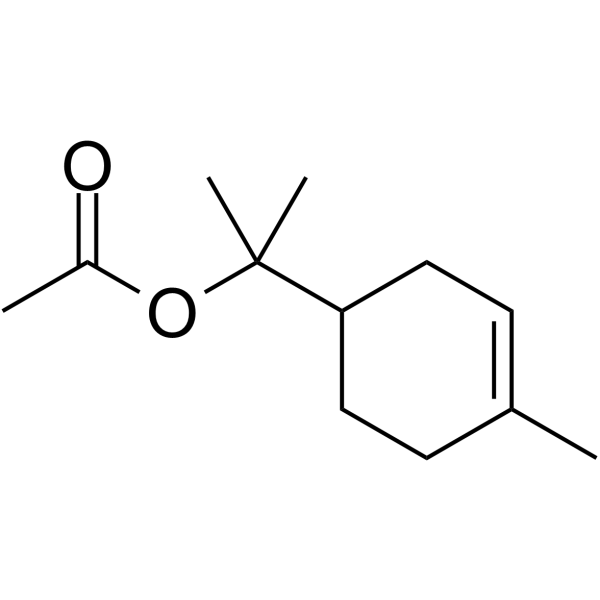
-
GC65446
α-Amyrin acetate
α-Amyrinacetat, ein natürliches Triterpenoid, hat eine entzündungshemmende Wirkung, ein krampflösendes Profil und eine entspannende Wirkung.
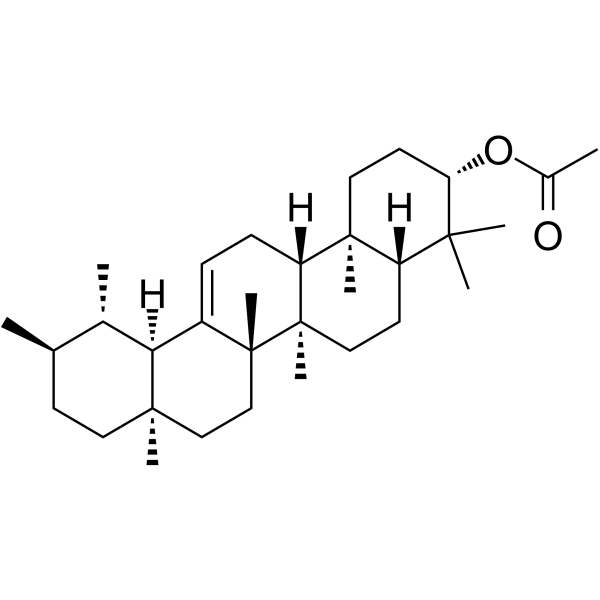
-
GC63268
α-Amyrin palmitate
α-Amyrinpalmitat wird aus Santalum album (Sandelholz) isoliert.
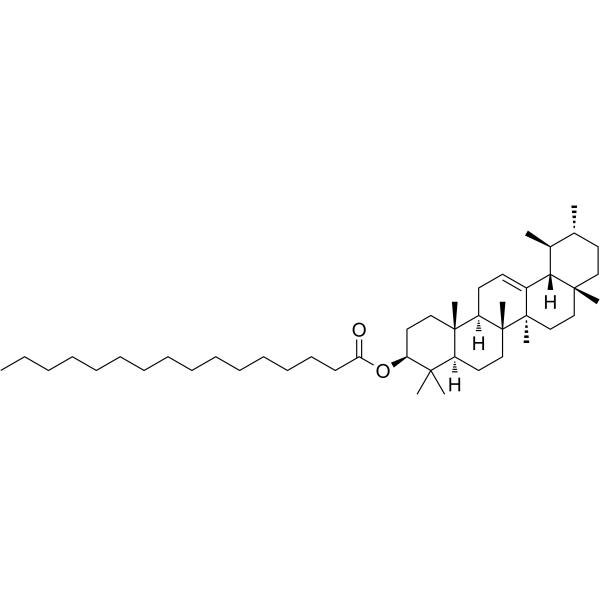
-
GC26093
α-Conotoxin GI
α-Conotoxin GI, a 13-residue peptide originally isolated from the venom of the fish-hunting cone snail Conus geographus, acts as a competitive antagonist for the muscle-type nicotinic acetylcholine receptor (nAChR) with excellent selectivity for α/δ receptor subunit binding over α/γ.
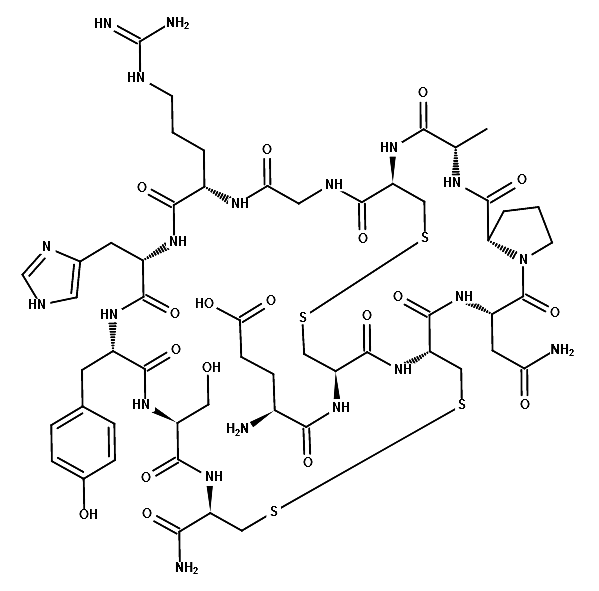
-
GC63269
α-Conotoxin PIA TFA
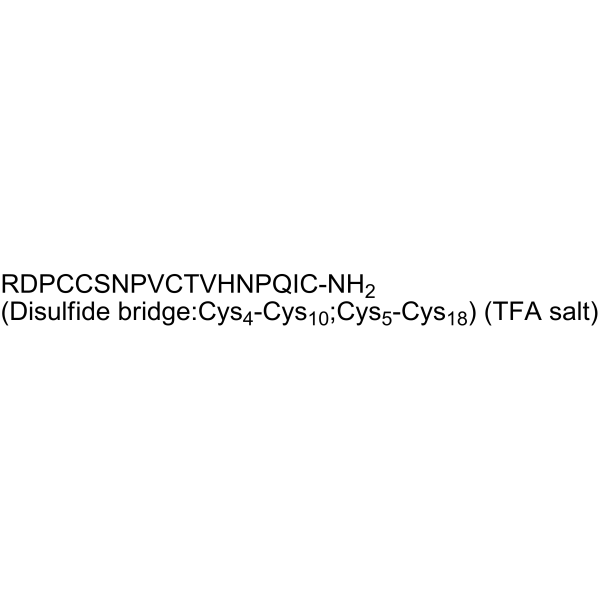
-
GC52338
α-Conotoxin PnIA (trifluoroacetate salt)
α-CtxPnIA, αPnIA
A peptide antagonist of α3β2-subunit containing and α7 nAChRs
-
GC63723
α-Conotoxin PnIA TFA
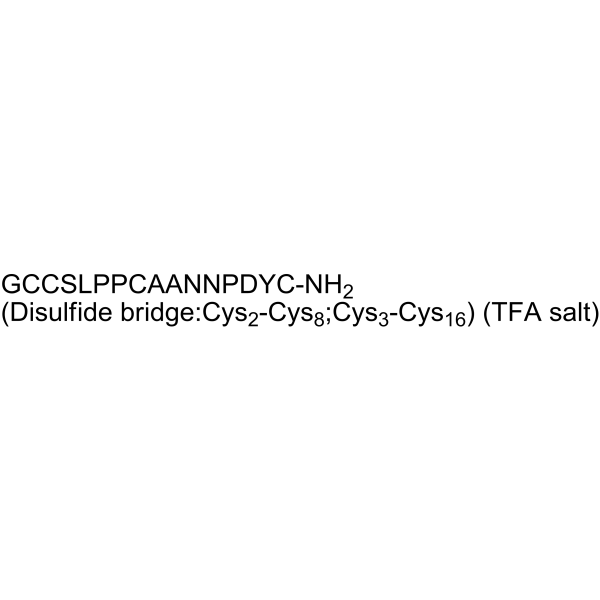
-
GC49838
α-Cortolone
20α-Cortolone, NSC 59872
A metabolite of cortisol
-
GC52253
α-Enolase (1-19)-biotin Peptide
Enolase-1 (1-19)-biotin
A biotinylated α-enolase peptide
-
GC70181
α-Glucosidase-IN-22
α-Glucosidase-IN-22 (Verbindung 7i) ist ein Benzimidazol, ein wirksamer Inhibitor der α-Glucosidase mit einer IC50 von 0,64 μM. α-Glucosidase-IN-22 ist eine wirksame anti-diabetische Wirkstoffverbindung mit Potenzial für die Forschung zur Typ-2-Diabetes (T2DM).
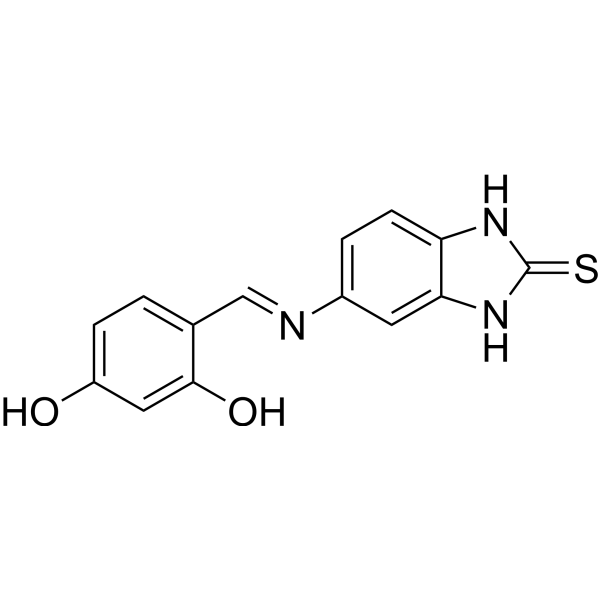
-
GC72710
α-Glucosidase-IN-35
α-Glucosidase-IN-35 (compound 1) is a kind of chromene.

-
GC66088
α-Helical CRF(9-41) TFA
α-Helical CRF(9-41) TFA ist ein kompetitiver CRF2-Rezeptorantagonist mit KB von ~100 nM. α-Helical CRF(9-41) TFA ist auch ein partieller Agonist des CRF1-Rezeptors mit einem EC50 von 140 nM.
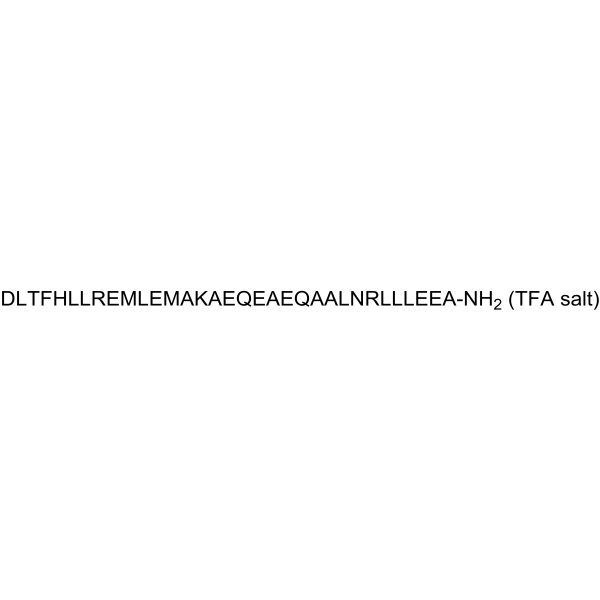
-
GC67685
α-Isopropylmalate
α-IPM

-
GC63749
α-Lipoic Acid-d5
Thioctic acid-d5; (±)-α-Lipoic acid-d5; DL-α-Lipoic acid-d5
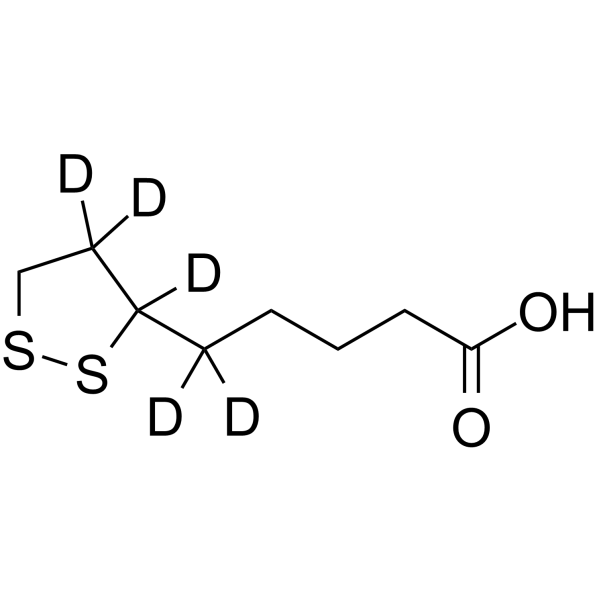
-
GC67540
α-Lipoic acid-NHS
DL-α-Lipoic acid-NHS
α-Liponsäure-NHS ist ein Alkyl/Ether-basierter PROTAC-Linker, der bei der Synthese von PROTACs verwendet werden kann.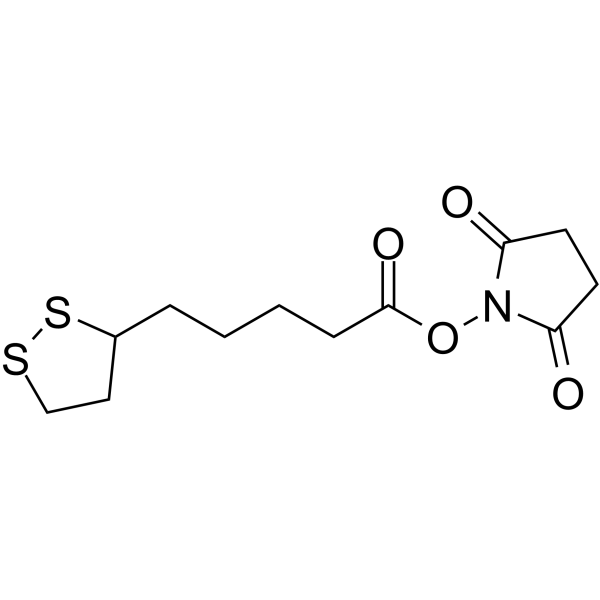
-
GC65892
α-Methyl-p-tyrosine
α-Methyl-p-tyrosine ist ein kompetitiver Inhibitor des Enzyms Tyrosinhydroxylase, das Tyrosin in Levodopa (DOPA) umwandelt. α-Methyl-p-tyrosine ist ein oral aktiver Inhibitor der Katecholaminsynthese, der die Hydroxylierung von Tyrosin zu DOPA hemmt.
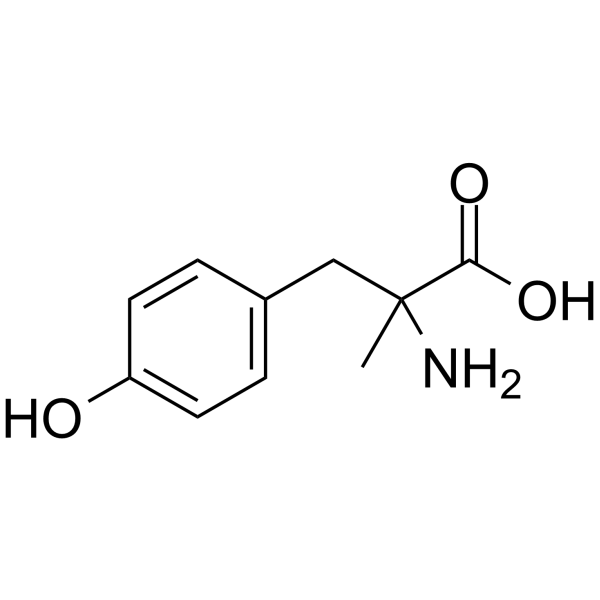
-
GC64563
α-Methylserotonin

-
GC63941
α-Solanine
α-Solanin, eine bioaktive Komponente und eines der wichtigsten steroidalen Glykoalkaloide in Kartoffeln, hemmt nachweislich das Wachstum und induziert Apoptose in Krebszellen.
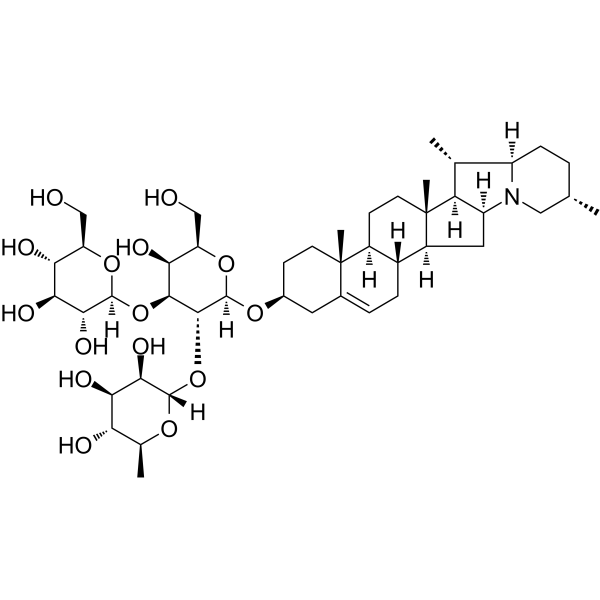
-
GC63615
α-Thujone
α-Thujon ist ein aus Ätherischem Thuja occidentalis-Öl isoliertes Monoterpen mit starken AntitumoraktivitÄten.
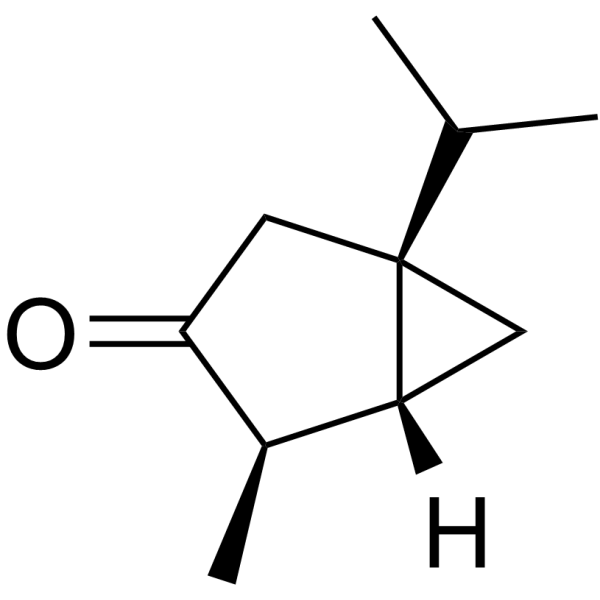
-
GC67618
α-Tocopherol phosphate disodium
alpha-Tocopherol phosphate disodium; TocP disodium; Vitamin E phosphate disodium
α-Tocopherolphosphat (Alpha-Tocopherolphosphat)-Dinatrium, ein vielversprechendes Antioxidans, kann vor langwelligem UVA1-induziertem Zelltod schützen und UVA1-induzierte ROS in einem Hautzellmodell abfangen. α-Tocopherolphosphat-Dinatrium besitzt therapeutisches Potenzial bei der Hemmung der Apoptose und erhöht die Migrationskapazität von endothelialen Vorläuferzellen unter Bedingungen mit hohem Glukosegehalt/Hypoxie und fördert die Angiogenese.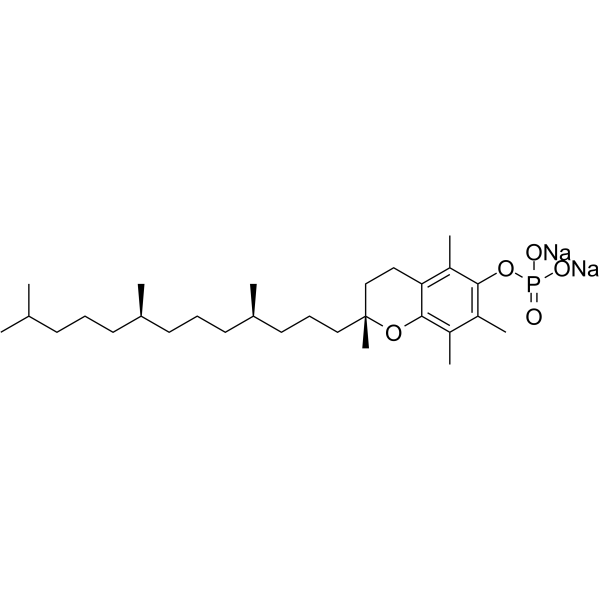
-
GC68390
α5β1 integrin agonist-1
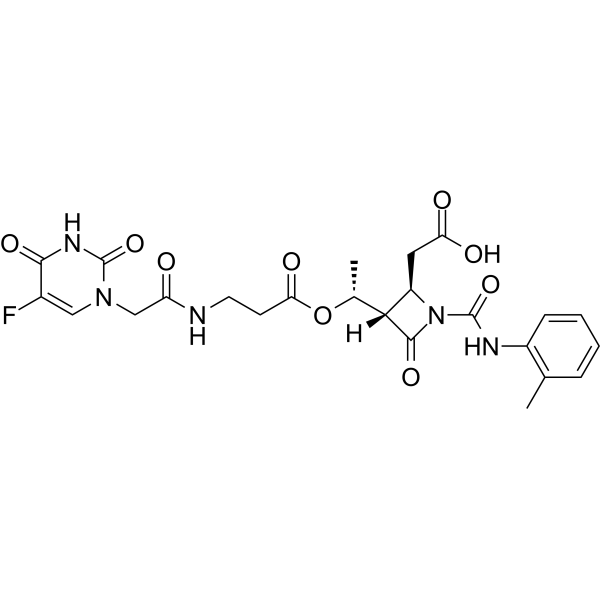
-
GC70953
α7 nAchR-JAK2-STAT3 agonist 1
α7 nAchR-JAK2-STAT3 agonist 1 is a potent α7 nAchR-JAK2-STAT3 agonist, with an IC50 value of 0.32 μM for nitric oxide (NO).

-
GC70179
α7 Nicotinic receptor agonist-1
α7 Nikotinrezeptor-Agonist-1 (Präparation 5) ist ein Agonist des α7 nAChR. Der α7 Nikotinrezeptor-Agonist-1 kann für die Erforschung von psychischen Störungen wie Schizophrenie, Manie oder manisch-depressiver Erkrankung und Angstzuständen sowie geistigen Beeinträchtigungen wie Alzheimer-Krankheit, Lernschwierigkeiten, kognitiven Defiziten, Aufmerksamkeitsdefiziten, Gedächtnisverlust, Lewy-Körper-Demenz und Aufmerksamkeitsdefizit-Hyperaktivitätsstörung verwendet werden.
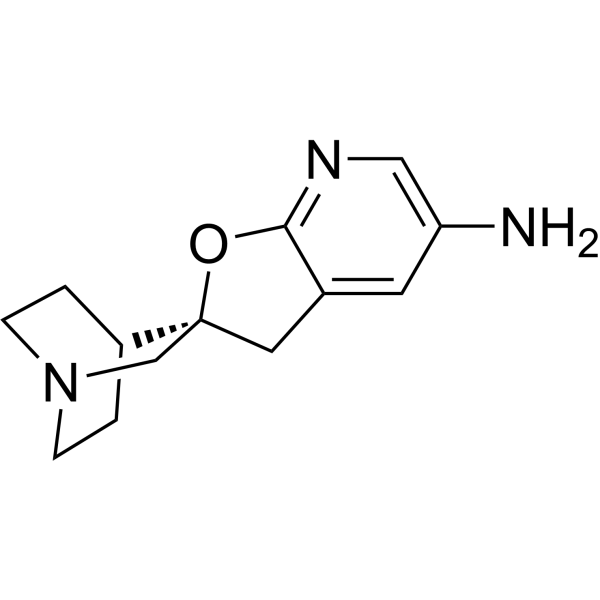
-
GC64932
αvβ5 integrin-IN-1
Der αvβ5-Integrin-Inhibitor IN-1 ist ein erstes potentes und selektives Hemmungsmittel des αvβ5-Integrins (pIC50 = 8,2).
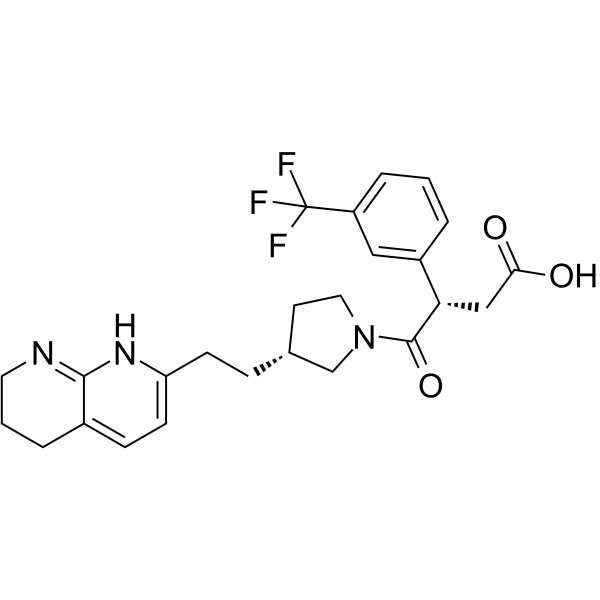
-
GC49467
β-Aescin
A triterpenoid saponin with diverse biological activities

-
GC70787
β-Aminoarteether
β-Aminoarteether (SM934 free base) is an Artemisinin derivative with orally active.

-
GC63273
β-Amyloid (1-14),mouse,rat
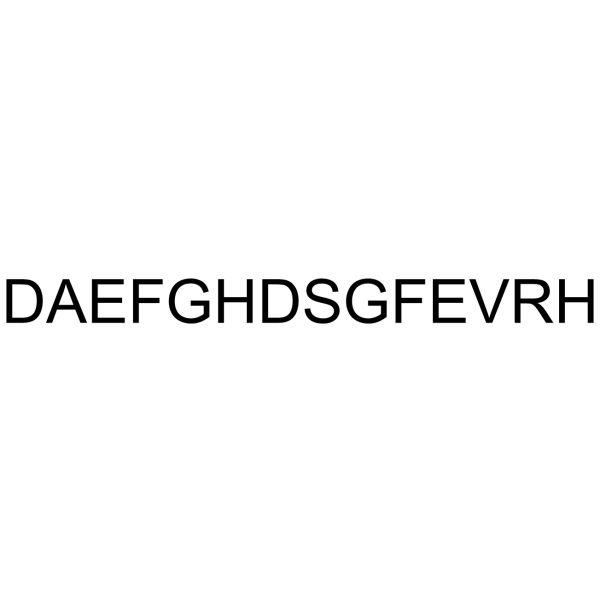
-
GC66089
β-Amyloid (1-40) (TFA)
Amyloid Beta-Peptide (1-40) (human) TFA; Amyloid β-Peptide (1-40) (human) TFA
β-Amyloid (1-40) TFA ist ein primÄres Protein in Plaques, die im Gehirn von Patienten mit Alzheimer-Krankheit gefunden werden.
-
GC70182
β-Amyloid (1-40), FAM-labeled TFA
β-Amyloid (1-40), FAM-markiert TFA ist ein mit FAM markiertes fluoreszierendes Peptid von β-Amyloid (1-40) (Λex= 492 nm und Λem= 518 nm).

-
GC63274
β-Amyloid (1-42), (rat/mouse) (TFA)
Amyloid β-peptide (1-42) (rat/mouse) TFA
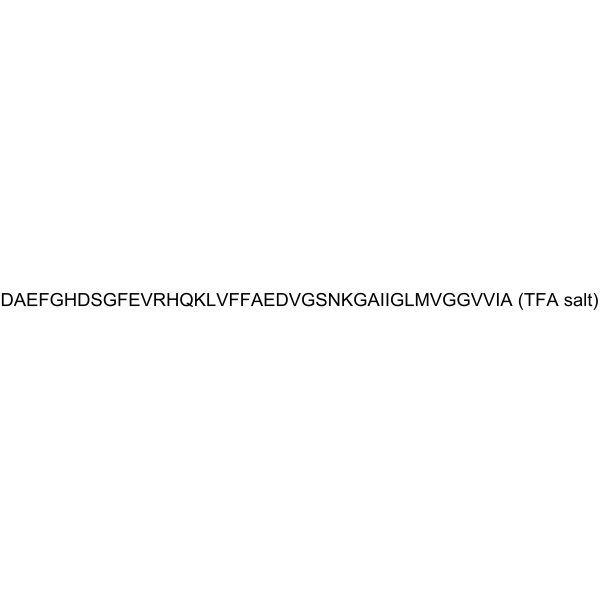
-
GC66416
β-Amyloid (22-35) (TFA)
Amyloid β-Protein (22-35) (TFA)
β-Amyloid 22-35 (Amyloid β-Protein 22-35) TFA, das Fragment der Reste 22-35 von β-Amyloid-Protein, hat eine zytotoxische Wirkung auf kultivierte Neuronen aus dem Hippocampus der Ratte in serumfreiem Medium. β-Amyloid 22-35 TFA bildet Aggregate und typische Amyloidfibrillen, die denen des &7#946;-Amyloidproteins in neutraler PufferlÖsung Ähneln).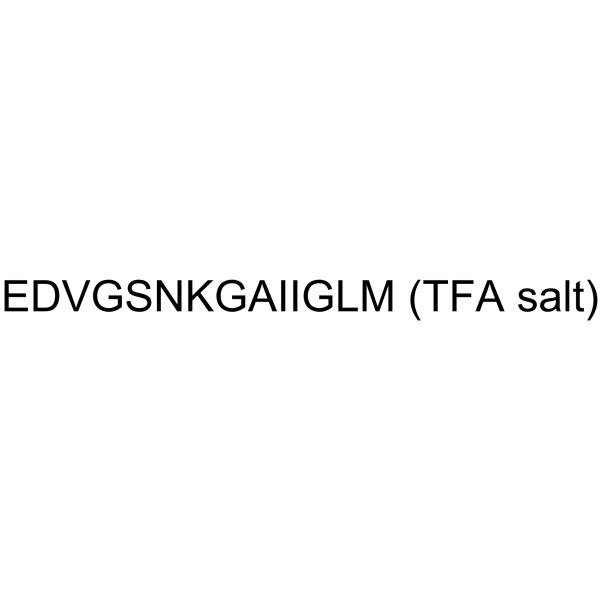
-
GC66346
β-Amyloid (42-1), human TFA
Amyloid β Peptide (42-1)(human) TFA
β-Amyloid (42-1), menschliches TFA ist die inaktive Form von Amyloid β Peptid (1-42). β-Amyloid (42-1), menschliches TFA, ist ein 42 AminosÄuren langes Peptid, das eine SchlÜsselrolle in der Pathogenese der Alzheimer-Krankheit spielt.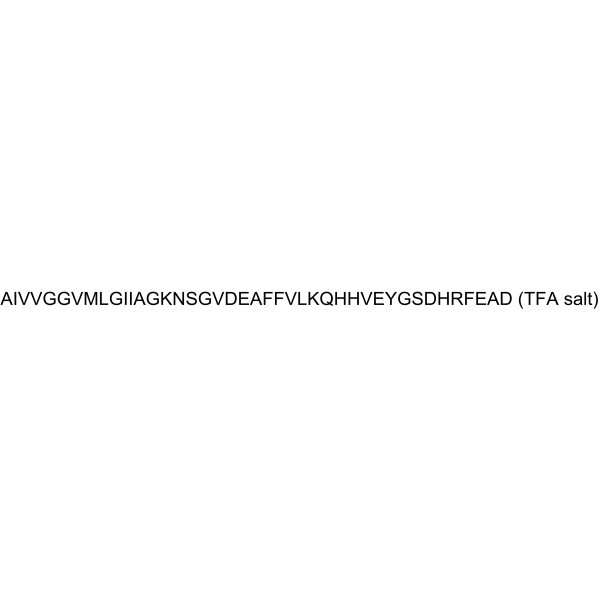
-
GC71998
β-Amyrin acetate
β-Amyrin acetate is a triterpenoid with potent anti-inflammatory, antifungal, anti-diabetic, anti-perlipidemic activities.

-
GC66340
β-Amyrone
β-Amyron
β-Amyron (β-Amyron) ist eine Triterpenverbindung, die entzÜndungshemmende Wirkung hat, indem sie die Expression von COX-2 hemmt. β-Amyrone hat eine antimykotische AktivitÄt sowie eine antivirale AktivitÄt gegen das Chikungunya-Virus. β-Amyron hemmt auch die AktivitÄt von α-Glucosidase und Acetylcholinesterase (AChE). β-Amyrone kann bei der Erforschung von Krankheiten wie EntzÜndungen, Infektionen und Fettleibigkeit eingesetzt werden.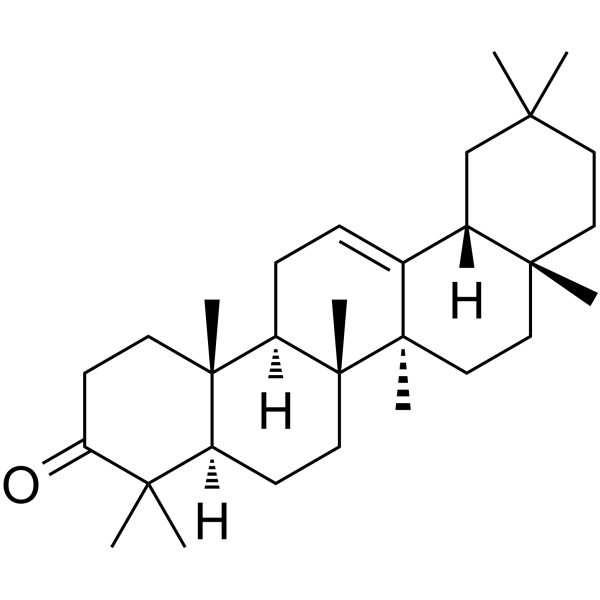
-
GC71980
β-Caryophyllene-d2
β-Caryopllene-d2 is deuterium labeled β-Caryopllene.

-
GC63275
β-Cryptoxanthin
β-Cryptoxanthin ((3R)-β-Cryptoxanthin), isoliert aus Satsuma-Mandarinenorange, ist ein sauerstoffreiches Carotinoid und ein starkes Antioxidans.
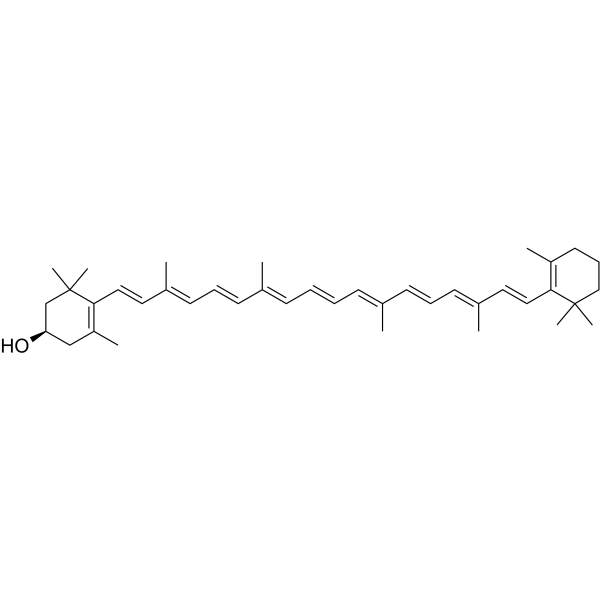
-
GC63276
β-Cyclocitral
β-Cyclocitral, ein flÜchtiges oxidiertes Derivat von β-Carotin, ist ein fÜr das Cyanobacterium Microcystis einzigartiges Grazer-Abwehrsignal.
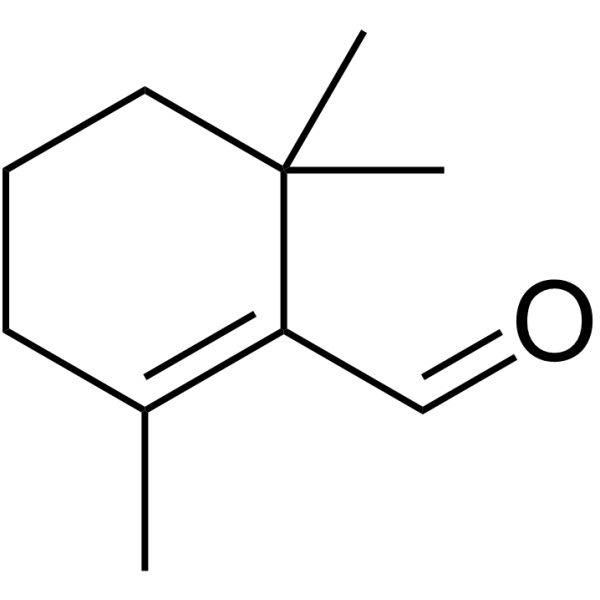
-
GC63277
β-Cyclogeraniol
β-Cyclogeraniol ist ein natÜrlicher Geruchsstoff.
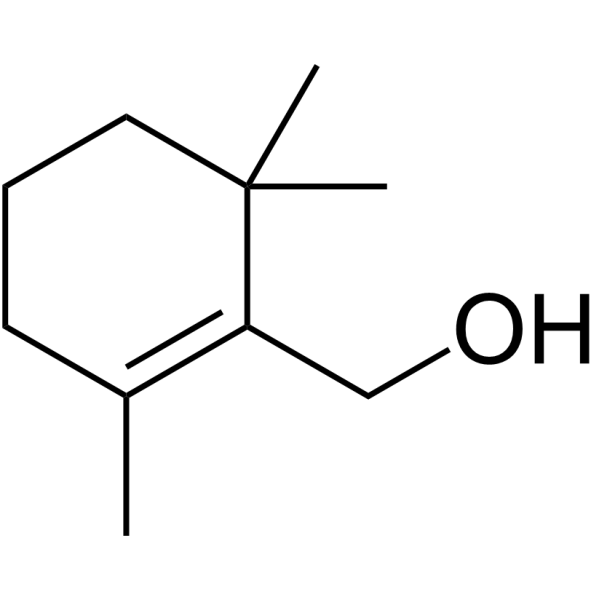
-
GC66870
β-D-Glucan
β-D-Glucan ist ein natürliches, unverdauliches Polysaccharid mit hoher Biokompatibilität, das selektiv von Erkennungsrezeptoren wie Dectin-1 und Toll-like-Rezeptoren erkannt werden kann und leicht von murinen oder menschlichen Makrophagen internalisiert werden kann, was wahrscheinlich der Fall ist Attribut zu einer Zielzustellung. β-d-Glucan ist ein enterisches Transportmittel für Probiotika.
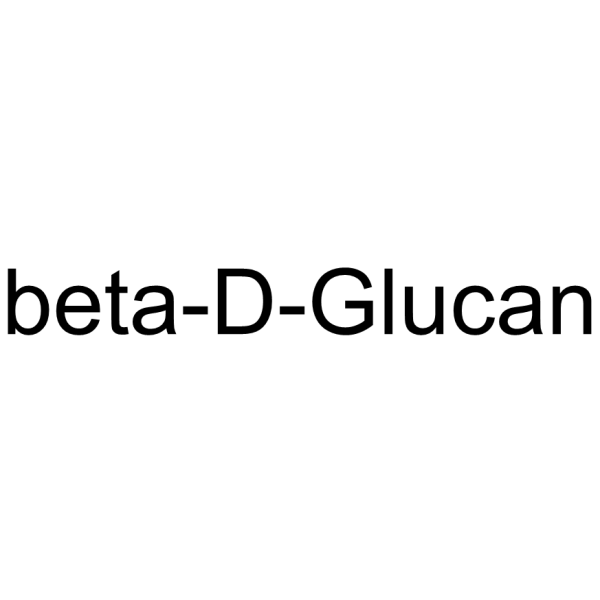
-
GC63278
β-D-Glucose pentaacetate
β-D-Glucose-Pentaacetat (Penta-O-acetyl-β-D-Glucopyranose) wird in biochemischen Reaktionen verwendet.
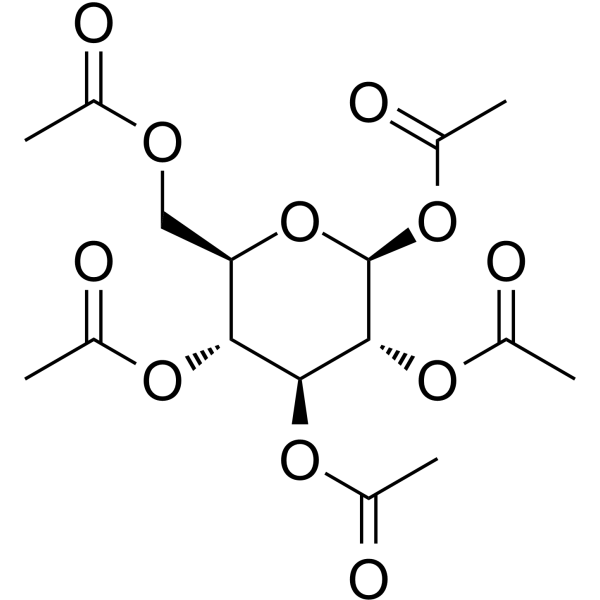
-
GC66750
β-D-glucuronide-pNP-carbonate
β-D-Glucuronid-pNP-Carbonat ist ein spaltbarer ADC-Linker, der bei der Synthese von Antikörper-Wirkstoff-Konjugaten (ADCs) verwendet wird.
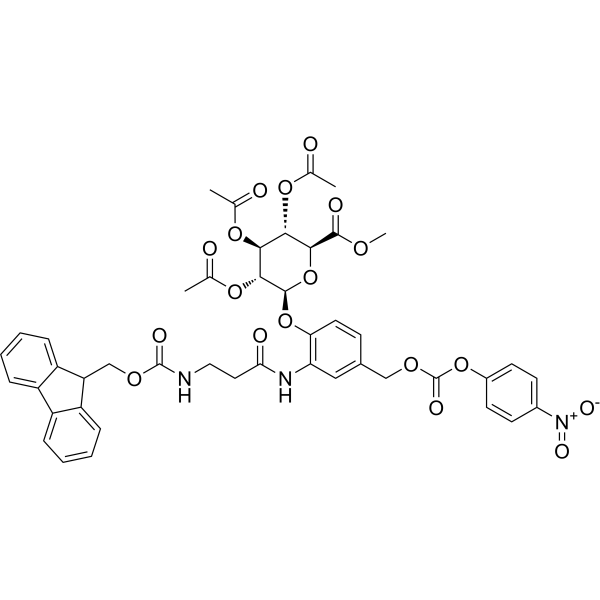
-
GC52494
β-Endorphin (rat) (trifluoroacetate salt)
An opioid neuropeptide

-
GC66512
β-Estradiol-6-one 6-(O-carboxymethyloxime)
β-Estradiol-6-on 6-(O-Carboxymethyloxim) ist ein Alkylketten-basierter PROTAC-Linker, der bei der Synthese von PROTACs verwendet werden kann.
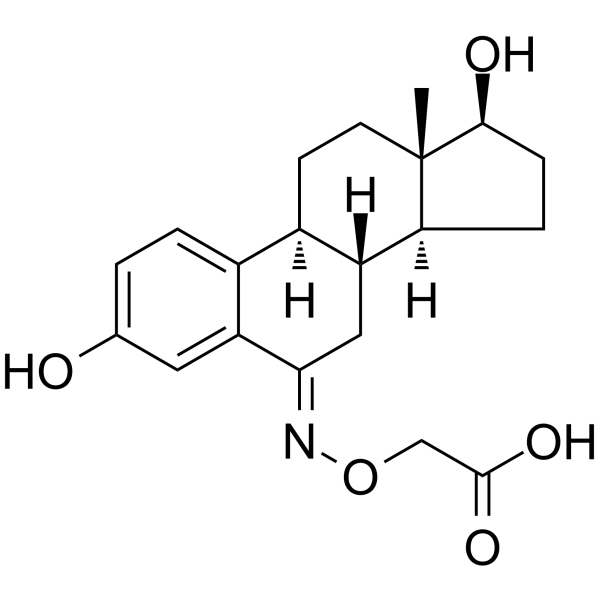
-
GC49769
β-Glucogallin
1-O-Galloyl-β-D-glucose
A plant metabolite and an aldose reductase 2 inhibitor
-
GC64430
β-Glucuronidase-IN-1
β-Glucuronidase-IN-1 ist eine potente, selektive, nicht kompetitive und oral aktive E.
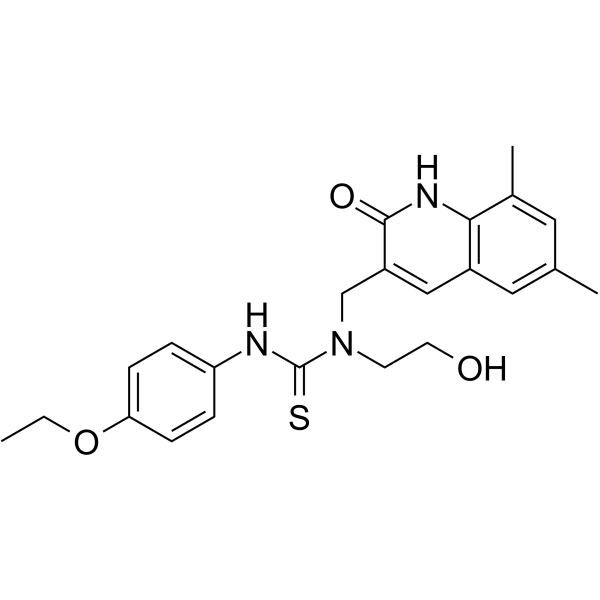
-
GC49890
β-Glycerophosphate-d5 (sodium salt hydrate)
Glycerol 2-Phosphate-d5
An internal standard for the quantification of β-glycerophosphate
-
GC49647
β-Hyodeoxycholic Acid (hydrate)
3β,6α-dihydroxy-5β-Cholan-24-oic Acid, isoHDCA, Isohyodeoxycholic Acid
A 3β epimer of hyodeoxycholic acid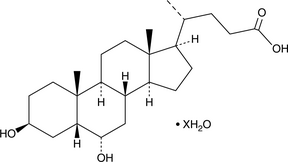
-
GC64619
β-Ionone
β-Ionone ist wirksam bei der Induktion von Apoptose in Adenokarzinomzellen des Magens SGC7901. Anti-Krebs-AktivitÄt.
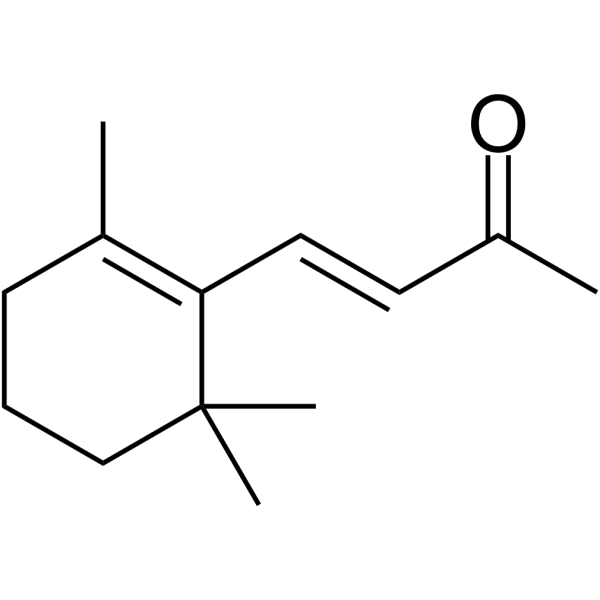
-
GC66842
β-Methylcrotonyl coenzyme A lithium
β-Methylcrotonyl Coenzym A Lithium ist ein Zwischenprodukt im Leucinstoffwechsel und kann als Substrat zur Untersuchung der Spezifität und Kinetik von β-Methylcrotonyl Coenzym A Carboxylase (MCCase) verwendet werden.
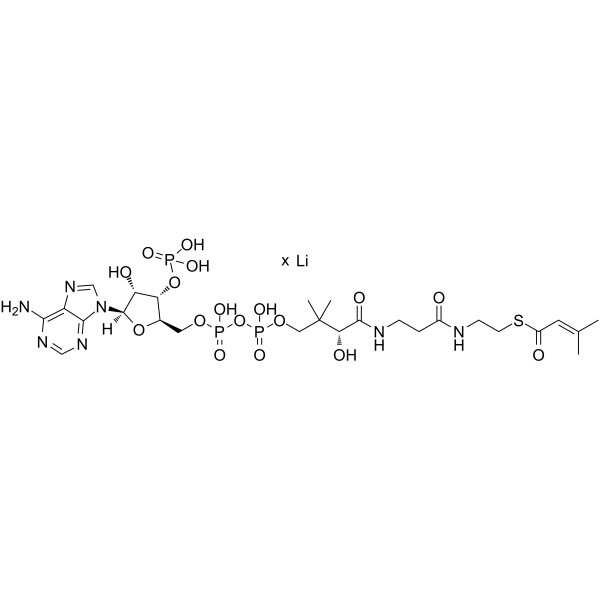
-
GC70184
β-Naphthoflavone-CH2-Br
β-NF-CH2-Br
β-Naphthoflavone-CH2-Br is a type of aromatic hydrocarbon receptor (AhR) ligand. It is used to synthesize PROTACβ-NF-JQ1.
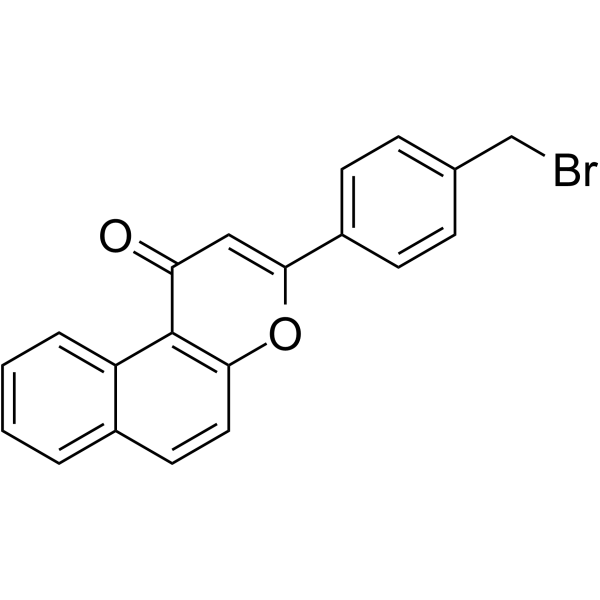
-
GC67484
β-Nicotinamide adenine dinucleotide reduced dipotassium
β-Nicotinamid-Adenin-Dinukleotid-reduziertes Dikalium ist ein oral aktives reduziertes Coenzym. β-Nicotinamidadenindinukleotid-reduziertes Dikalium ist ein Donor von ADP-Riboseeinheiten in ADP-Ribosylierungsreaktionen und ein Vorläufer von zyklischer ADP-Ribose. β-Nicotinamidadenindinukleotid-reduziertes Dikalium spielt eine Rolle als regenerativer Elektronendonor im zellulären Energiestoffwechsel, einschließlich Glykolyse, β-Oxidation und Tricarbonsäure (TCA)-Zyklus.
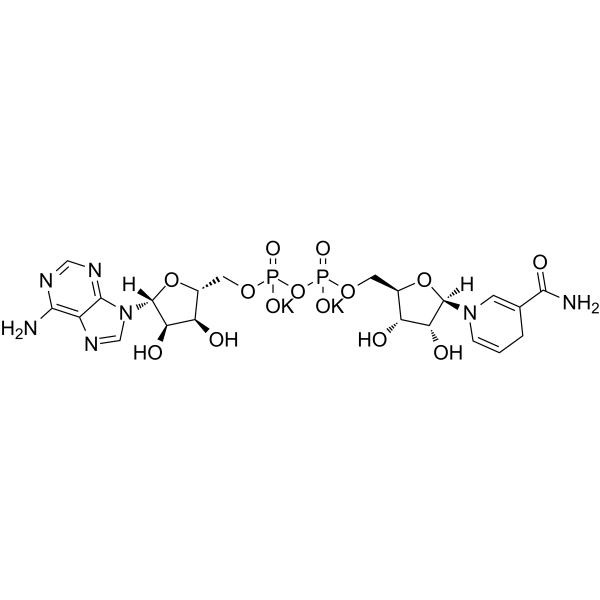
-
GC70185
β-Sitostenone
δ4-Sitosterol-3-one; β-Rosasterol oxide
β-Sitostenon ist ein Steroid, das aus Cochlospermum vitifolium isoliert wurde. Es kann die Aktivität des Enzyms Tyrosinase hemmen und hat anti-melanogene und antitumorale Eigenschaften.

-
GC70650
γ-Acetylenic GABA hydrochloride
γ-Acetylenic GABA (GAG) drochloride is an irreversible inhibitor of GABA-transaminase.

-
GC64508
γ-Aminobutyric acid-d6
γ-Aminobuttersäure-d6 (4-Aminobuttersäure-d6) ist die deuterierte Form von γ-Aminobuttersäure.

-
GC49865
γ-D-Glutamylglycine (trifluoroacetate salt)
γ-DGG
An excitatory amino acid antagonist
-
GC52400
γ-Glu-Ala (trifluoroacetate salt)
γ-Glutamylalanine, γ-L-Glutamyl-L-alanine
A dipeptide
-
GC63279
γ-Glu-Gly TFA
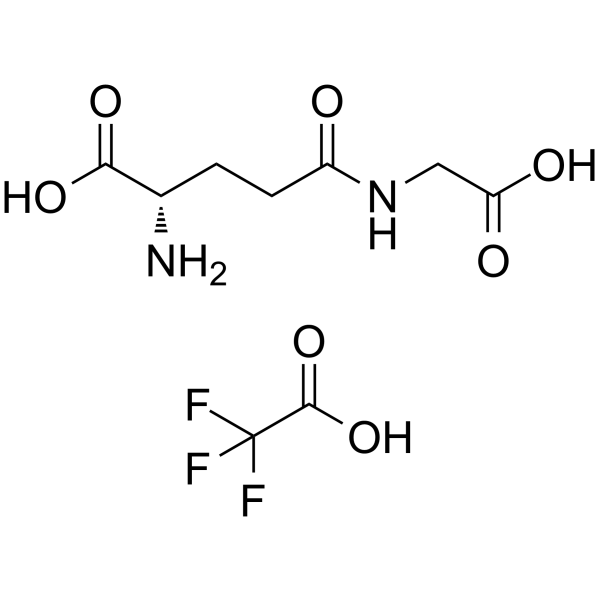
-
GC52404
γ-Glu-Phe (trifluoroacetate salt)
γ-Glutamylphenylalanine
A dipeptide with metabolism-altering activity
-
GC70186
γ-Glutamylornithine
γ-Glutamylornithin ist ein Ausscheidungsprodukt im Urin von Patienten mit HHH-Syndrom (Hyperurikämie, Hyperammonämie und Hyperornithinämie) sowie bei Patienten mit zirkulärer Atrophie in Verbindung mit Hyperurikämie. Ein Anstieg des endogenen Arginin führt zu einem Anstieg des γ-Glutamylornithinspiegels im Urin.
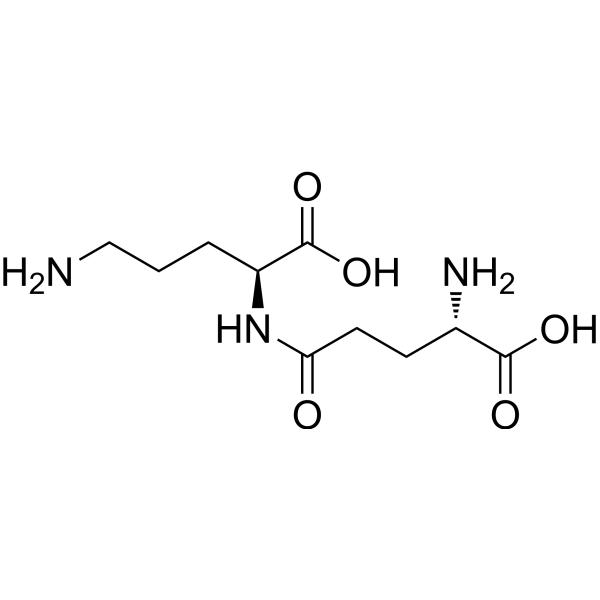
-
GC63280
γ-Hexalactone
γ-Hexalacton ist ein Gamma-Lacton, das in reifen Früchten vorkommt.
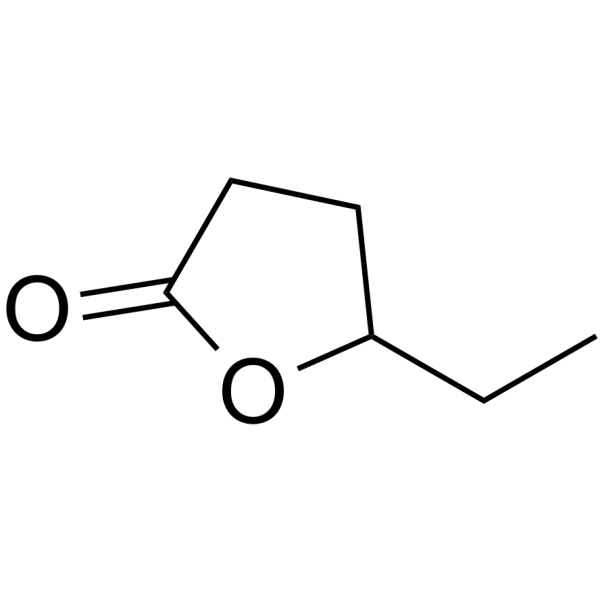
-
GC66048
δ-Secretase inhibitor 11
δ-Secretase-Inhibitor 11 (Verbindung 11) ist ein oral aktiver, potenter, BHS-penetrierter, nicht toxischer, selektiver und spezifischer ⋴-Secretase-Inhibitor mit einem IC50 von 0,7 μM. δ-Secretase-Inhibitor 11 interagiert sowohl mit dem aktiven Zentrum als auch mit dem allosterischen Zentrum von δ-Secretase. δ-Secretase Inhibitor 11 schwÄcht die Spaltung von Tau und APP (Amyloid Precursor Protein) ab. δ-Secretase-Inhibitor 11 verbessert synaptische Dysfunktion und kognitive BeeintrÄchtigungen in transgenen Mausmodellen mit Tau P301S und 5XFAD. δ-Secretase Inhibitor 11 kann fÜr die Erforschung der Alzheimer-Krankheit verwendet werden.
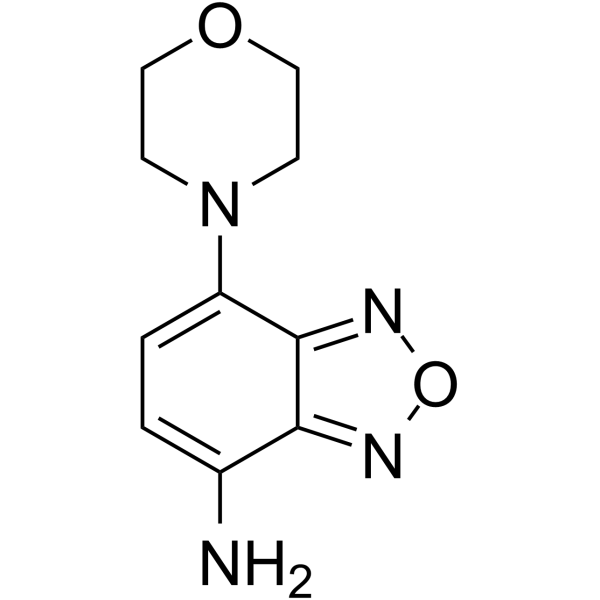
-
GC70188
ω-Agatoxin IVA TFA
ω-Agatoxin IVA TFA ist ein wirksamer selektiver Blocker des P/Q-Typs Ca2+ (Cav2.1) Kanals, mit einer IC50 von 2 nM bzw. 90 nM für den P- und Q-Typ Ca2+ Kanal. ω-Agatoxin IVA TFA (IC50, 30-225 nM) hemmt die Glutamatfreisetzung und den Calciumeinstrom, die durch hohe Kaliumkonzentrationen verursacht werden. ω-Agatoxin IVA TFA kann auch die Freisetzung von Serotonin und Noradrenalin blockieren, die durch hohes Kalium induziert wird, hat jedoch keine Auswirkungen auf L- oder N-Typ Calciumkanäle.
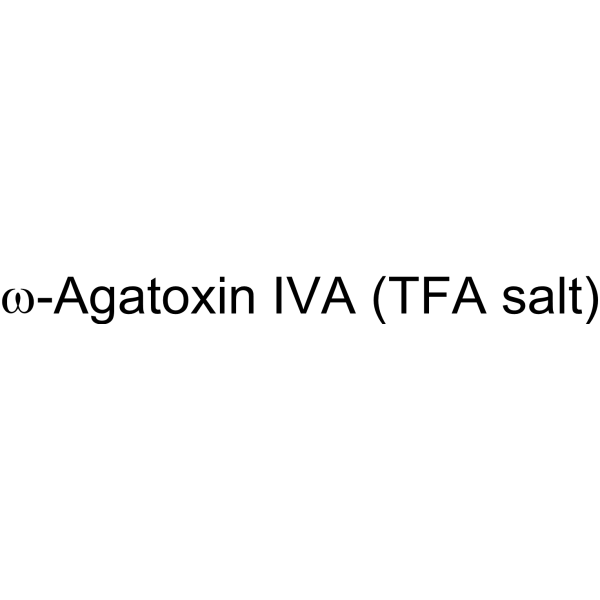
-
GC64899
ω-Conotoxin MVIIC TFA
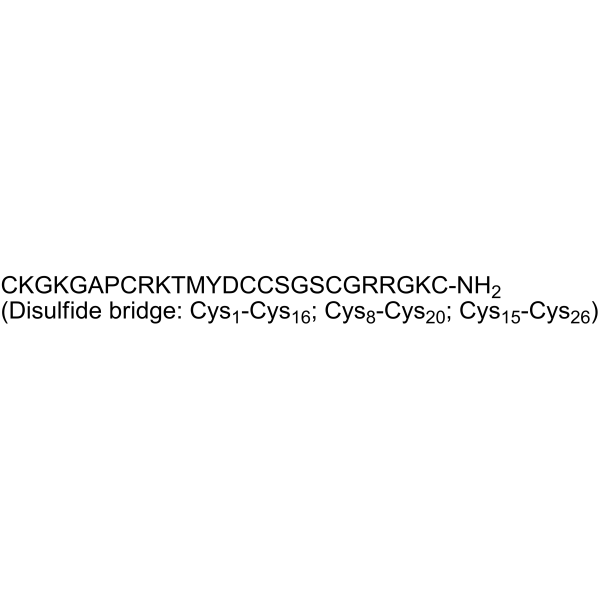
-
GC63281
ω-Pentadecalactone
ω-Pentadecalacton ist ein Duftstoff.
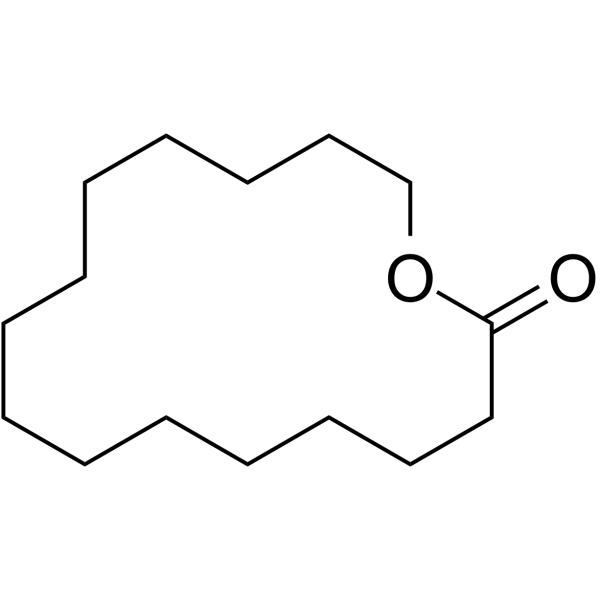
-
GC70556
ß-pBrPh-Glc
β-pBrPh-Glc is a small-molecule ice recrystallization inhibitor.

-
GC67191
(±)-α-Tocopherol nicotinate
(±)-α-Tocopherolnicotinat, Vitamin E-Nicotinat, ist ein oral wirksames fettlösliches Antioxidans, das die Lipidperoxidation in Zellmembranen verhindert. (±)-α-Tocopherolnicotinat wird im Blut zu α hydrolysiert; -Tocopherol und Niacin und kann in Studien verwandter Gefäßerkrankungen verwendet werden.
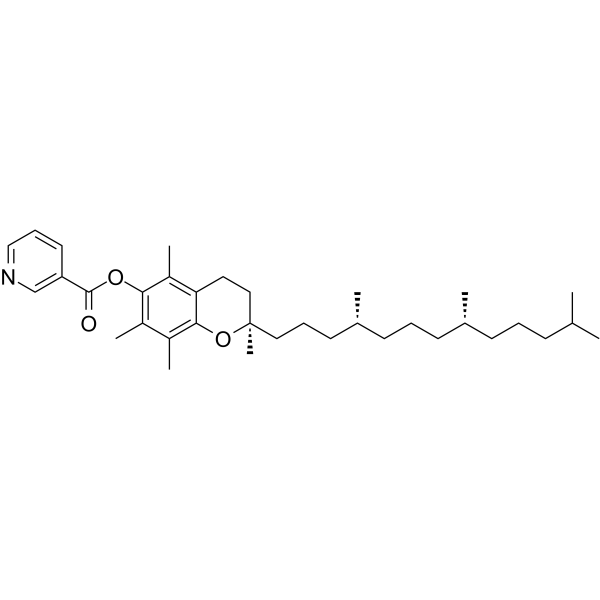
-
GC52010
(±)-10-hydroxy-12(Z),15(Z)-Octadecadienoic Acid
αHYA, (±)-10-hydroxy-12(Z),15(Z)-ODE
An oxylipin gut microbiota metabolite
-
GC52013
(±)-10-hydroxy-12(Z)-Octadecenoic Acid
10-hydroxy-cis-12-Octadecenoic Acid
An oxylipin and metabolite of linoleic acid
-
GC52421
(±)-10-hydroxy-12(Z)-Octadecenoic Acid-d5
10-hydroxy-cis-12-Octadecenoic Acid-d5
An internal standard for the quantification of (±)-10-hydroxy-12(Z)-octadecenoic acid
-
GC52260
(±)-Cenobamate
An Analytical Reference Standard

-
GC72625
(±)-Coniine hydrochloride
(±)-Coniine drochloride (2-Propylpiperidine drochloride) is a potent nAChR agonist with an EC50 value of 0.3 mM.

-
GC49515
(±)-Ibuprofen-d3 (sodium salt)
DL-Ibuprofen-d3
An internal standard for the quantification of (±)-ibuprofen
-
GC65599
(±)-Leucine-d10
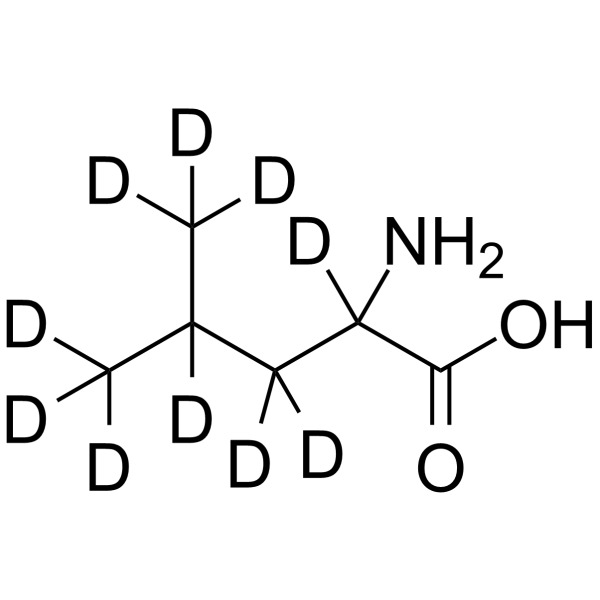
-
GC52224
(±)-MMT5-14
A derivative of remdesivir with antiviral activity

-
GC49875
(±)-N-desmethyl Venlafaxine (hydrochloride)
Wy 45494
A minor active metabolite of venlafaxine
-
GC49482
(±)-Nornicotine-d4
DL-Nornicotine-d4, (R,S)-Nornicotine-d4
An internal standard for the quantification of (±)-nornicotine
-
GC67928
(±)-Stylopine hydrochloride
Tetrahydrocoptisine hydrochloride
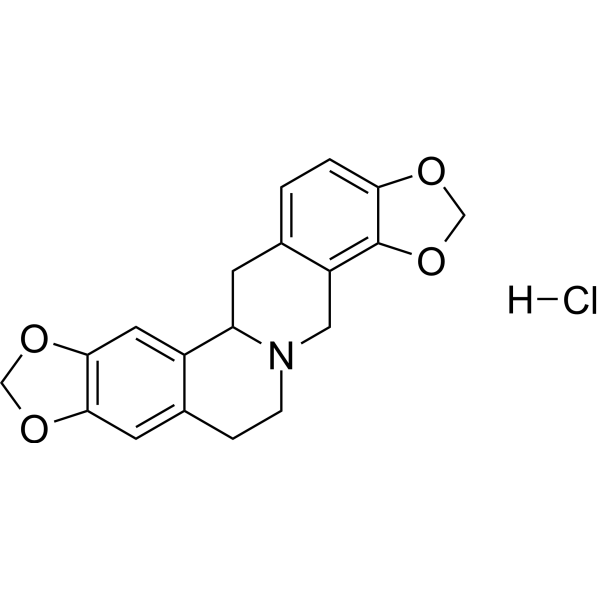
-
GC64007
(±)-U-50488 hydrate hydrochloride
(±)-Trans-(1R,2R)-U-50488 hydrate hydrochloride
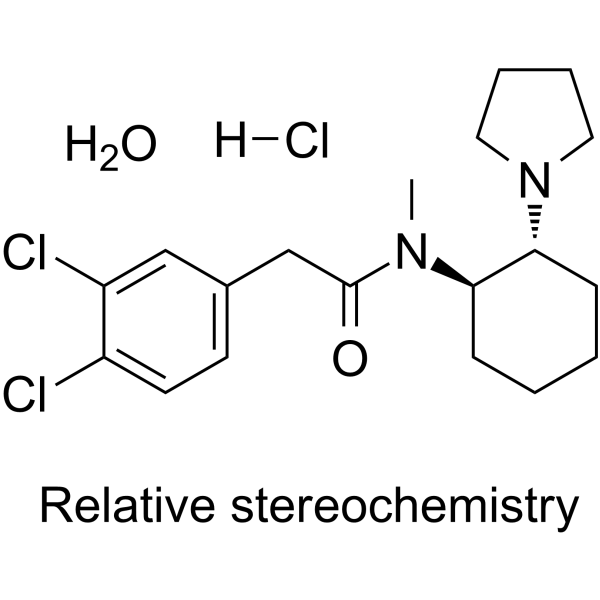
-
GC67681
(αR,8aS)-GSK1614343
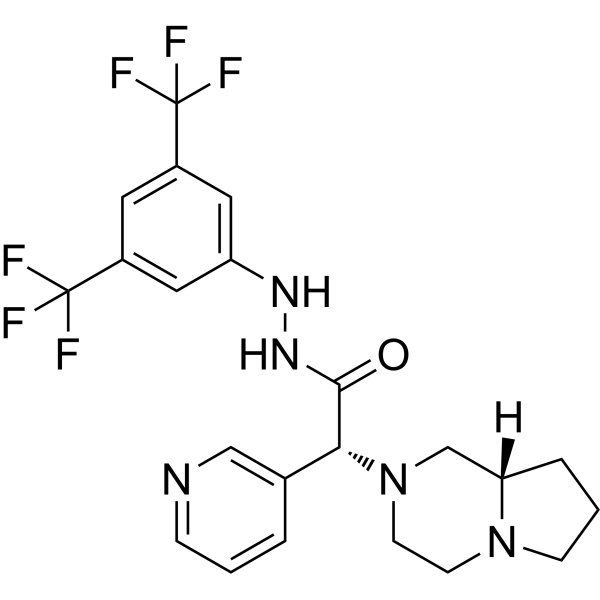
-
GN10155
(+)- Corydaline
(+)-Corydaline, D-Corydaline, NSC 406036
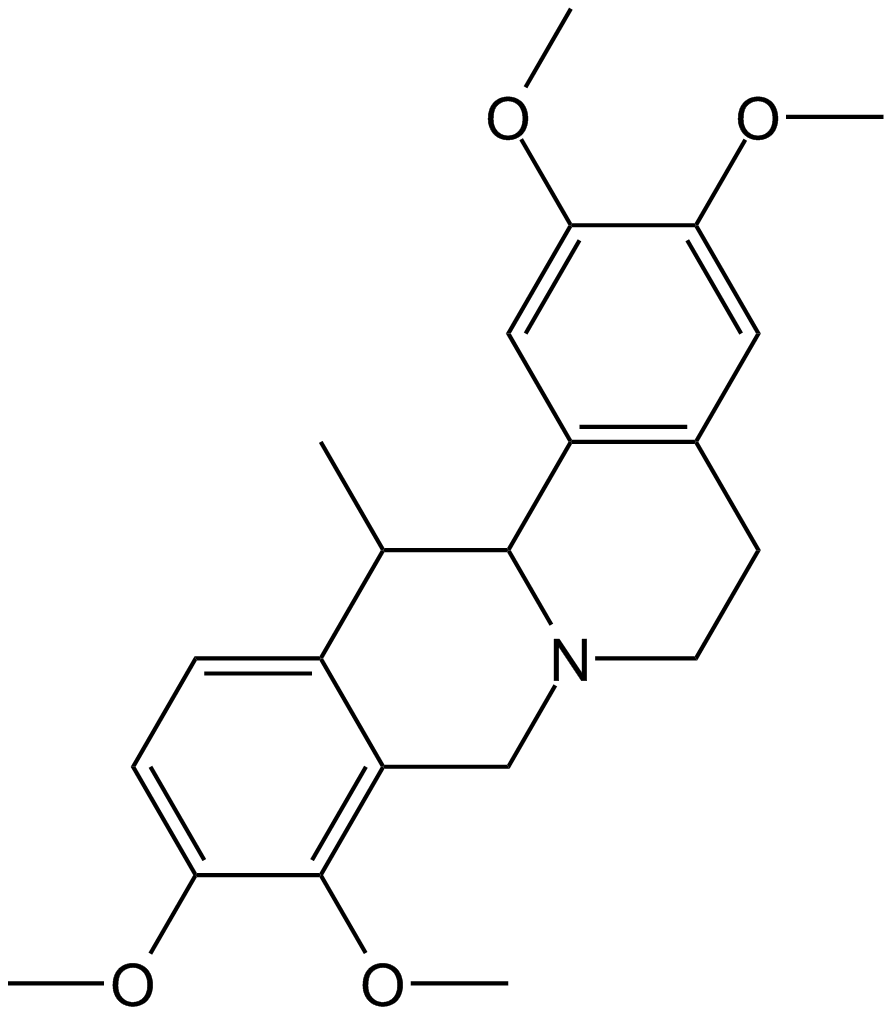
-
GN10612
(+)- Praeruptorin C

-
GN10745
(+)-Bicuculline
NSC 32192
(+)-Bicucullin ist ein lichtempfindlicher kompetitiver Antagonist des GABA-A-Rezeptors.
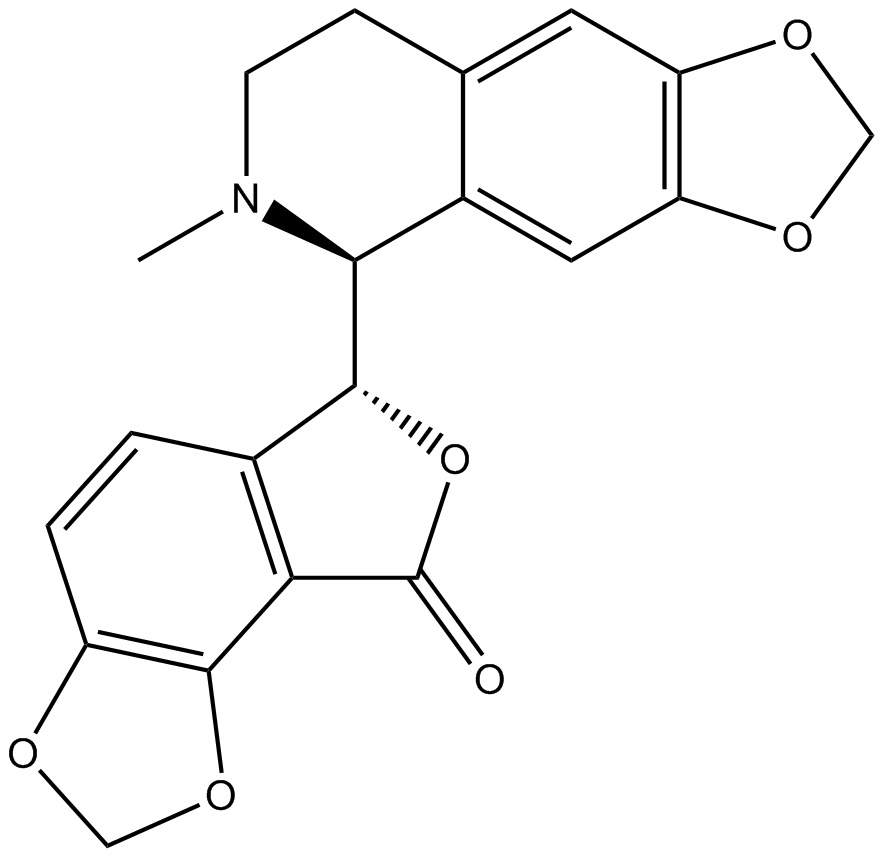
-
GC64752
(+)-Biotin-ONP
(+)-Biotin 4-nitrophenyl ester
(+)-Biotin-ONP ist ein Alkylketten-basierter PROTAC-Linker, der bei der Synthese von PROTACs verwendet werden kann.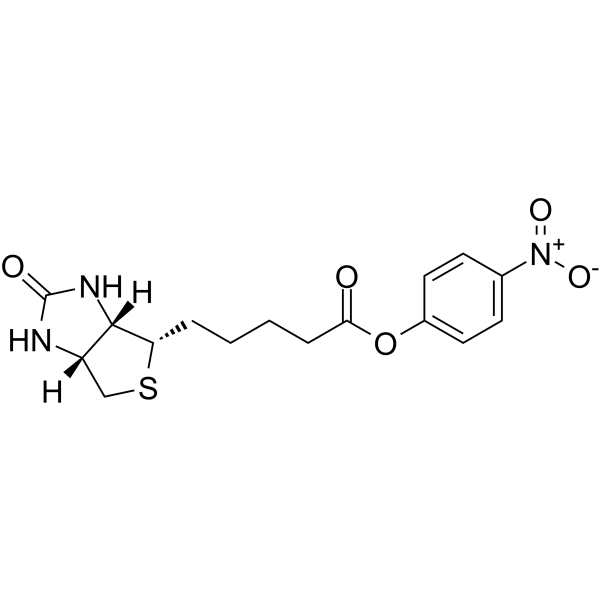
-
GC66864
(+)-Biotin-PEG2-hydrazide
(+)-Biotin-PEG2-hydrazid ist ein PEG-basierter PROTAC-Linker, der bei der Synthese von PROTACs verwendet werden kann.
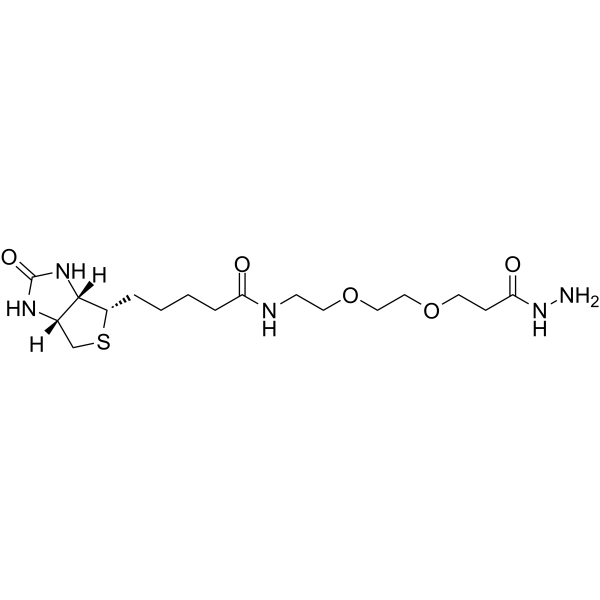
-
GC66692
(+)-Biotin-SLC
(+)-Biotin-SLC ist ein Alkylketten-basierter PROTAC-Linker, der bei der Synthese von PROTACs verwendet werden kann.
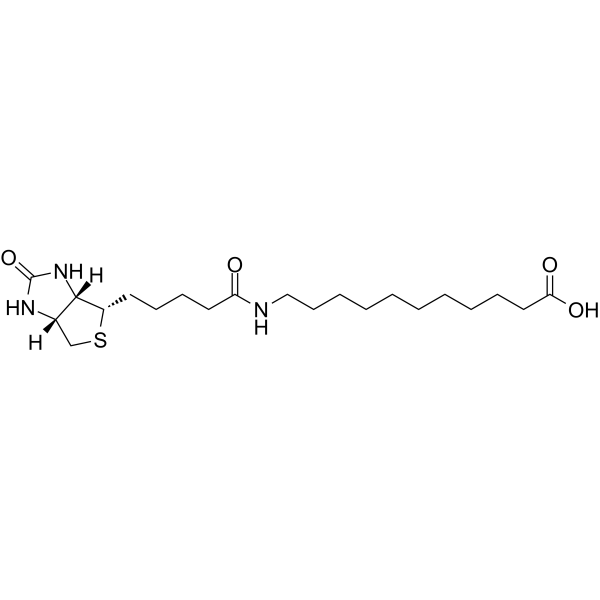
-
GN10605
(+)-Catechin hydrate
D-(+)-Catechin, Catechuic Acid, Cyanidol
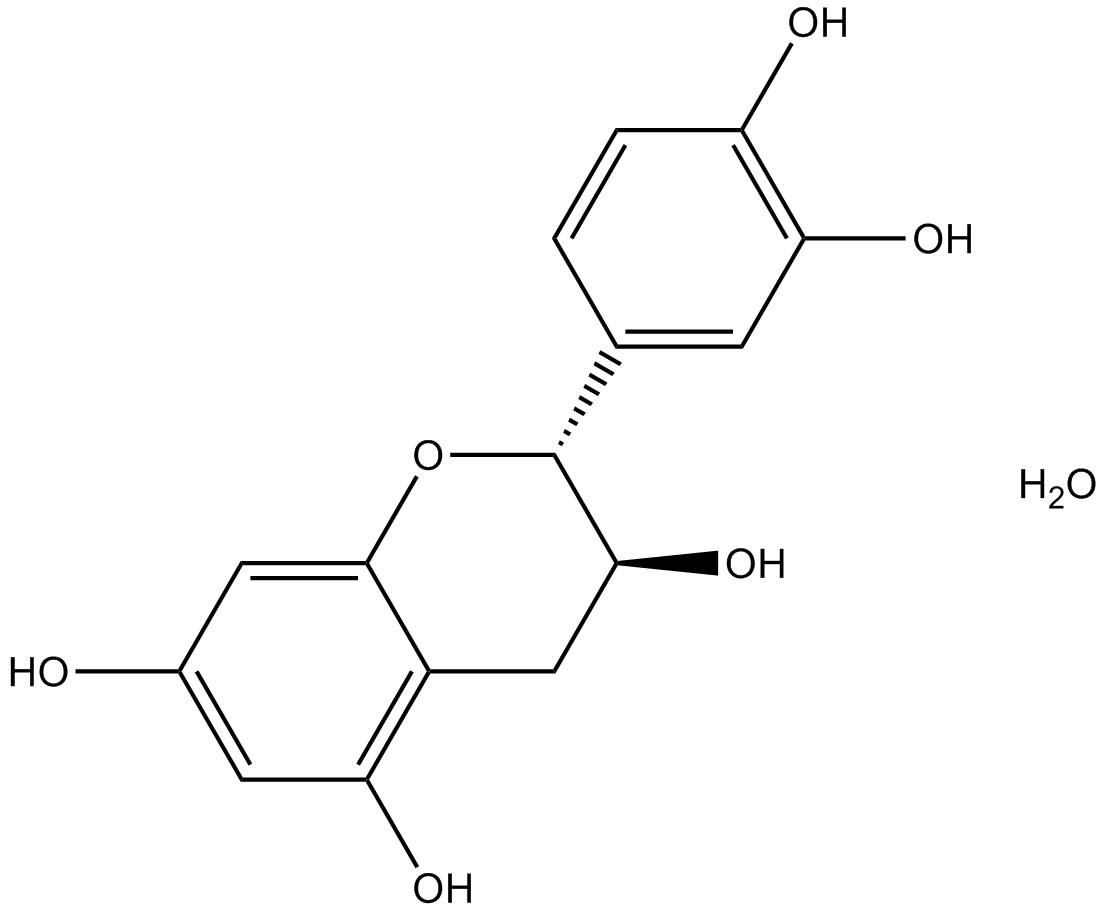
-
GC63999
(+)-Coclaurine hydrochloride
(+)-(R)-Coclaurine hydrochloride; (R)-Coclaurine hydrochloride; d-Coclaurine hydrochloride
(+)-Coclaurin ((+)-(R)-Coclaurin)-Hydrochlorid, Benzyltetrahydroisochinolin-Alkaloid, isoliert aus einer Vielzahl pflanzlicher Quellen.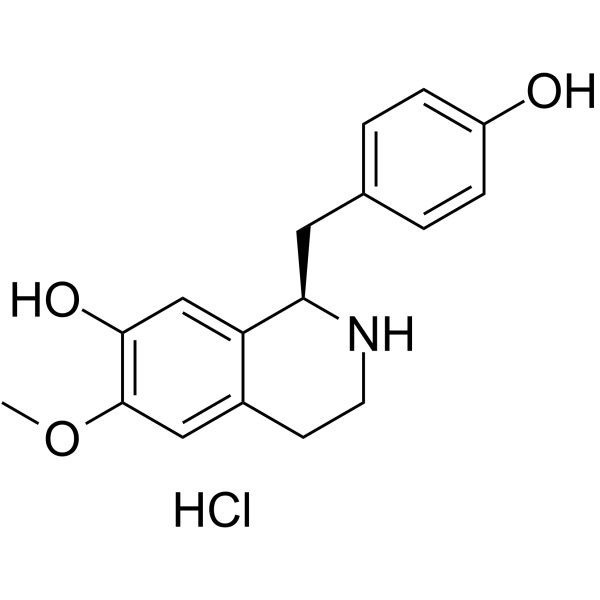
-
GN10654
(+)-Corynoline
(+)-Corynoline, 13-methyl-Chelidonine, CRL, (d)-Corynoline
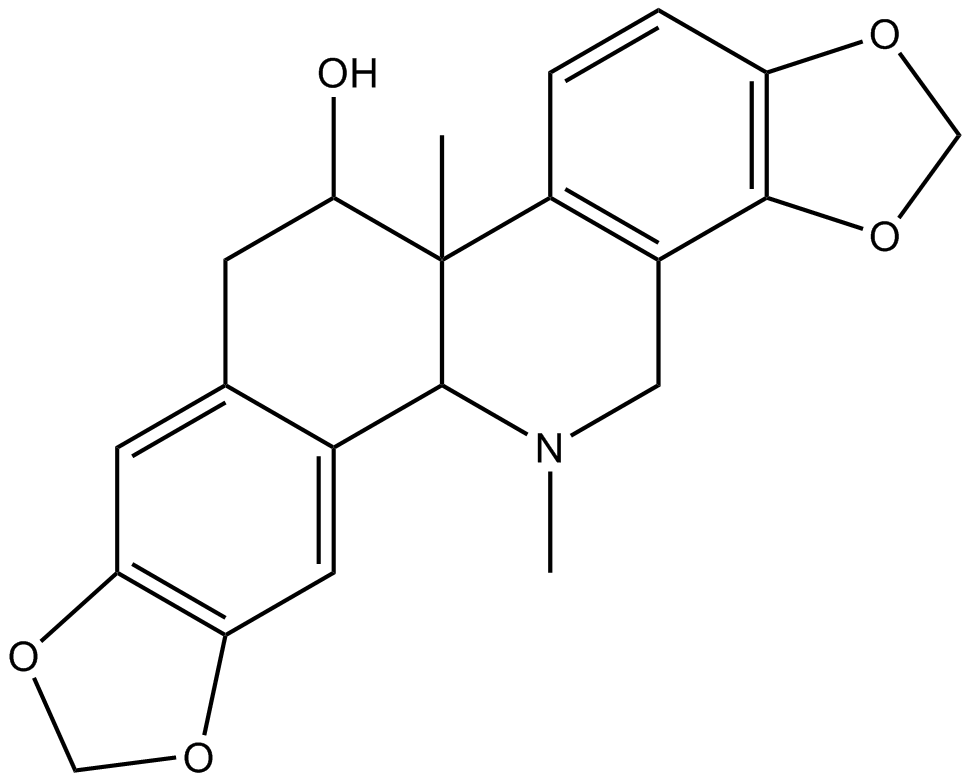
-
GC70265
(+)-EMD 57033
(+)-EMD 57033 is a cardiac troponin C (cTnC) activator, is a dominant Ca2+ sensitizer.

-
GC64207
(+)-JNJ-A07
(+)-JNJ-A07 ist ein hochwirksamer, oral aktiver Pan-Serotyp-Dengue-Virus-Inhibitor, der auf die NS3-NS4B-Interaktion abzielt.
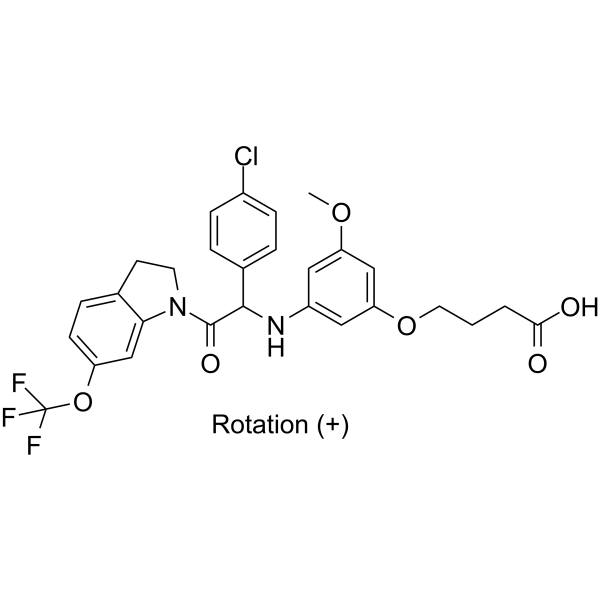
-
GC67931
(+)-Medioresinol
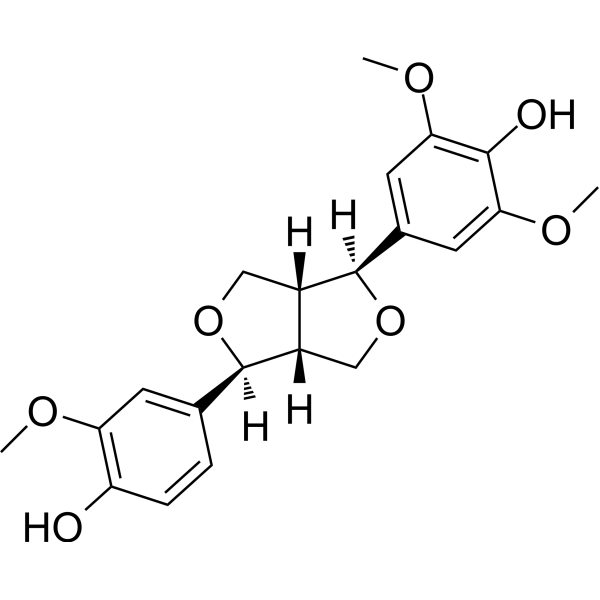
-
GC16616
(+)-MK 801
Dizocilpine maleate;Dizocilpine hydrogen maleate;(+)-MK 801;MK 801
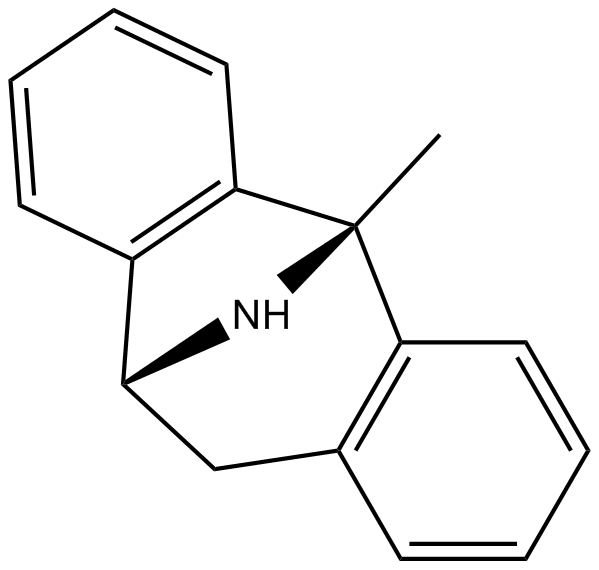
-
GC68210
(+)-Norfenfluramine

-
GC63969
(+)-Schisandrin B
(+)-Schisandrin B ist ein Enantiomer von Schisandrin B.
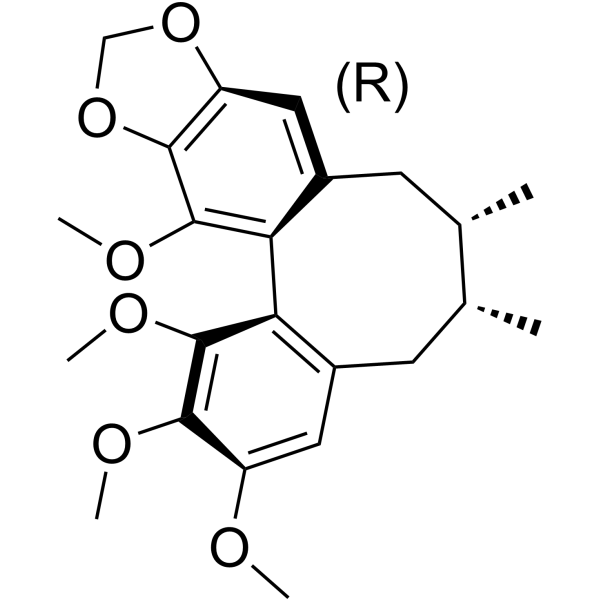
-
GC69720
(+)SHIN2
(+)SHIN2 ist ein Hemmstoff der Serinhydroxymethyltransferase (SHMT) und sein Ziel im Körper kann mit 13C-Serin verfolgt werden. (+)SHIN2 erhöht die Überlebensrate von Mäusen, die an primärer akuter T-Zell-Leukämie (T-ALL), die durch Notch1 angetrieben wird, leiden, und wirkt synergistisch mit Methotrexat zusammen.
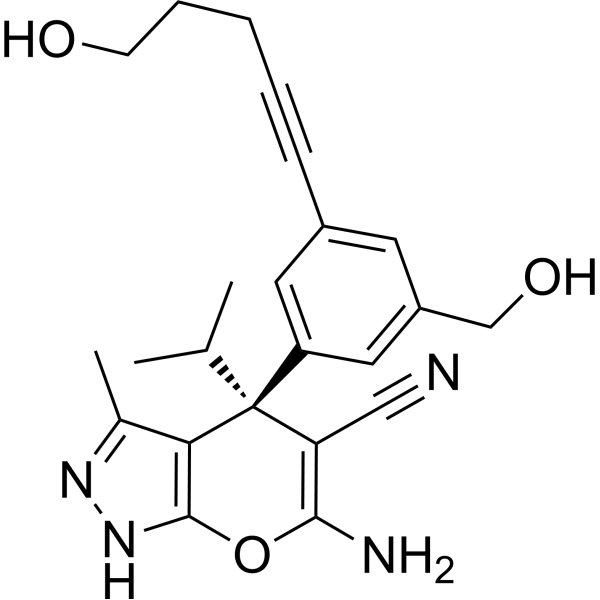
-
GC49502
(-)-β-Sesquiphellandrene
A sesquiterpene with antiviral and anticancer activities

-
GC63940
(-)-Denudatin B
(-)-Denudatin B ist ein Thrombozytenaggregationshemmer.

-
GC14049
(-)-Epigallocatechin gallate (EGCG)
EGCG
Ein Phenol mit vielfältigen biologischen Aktivitäten.
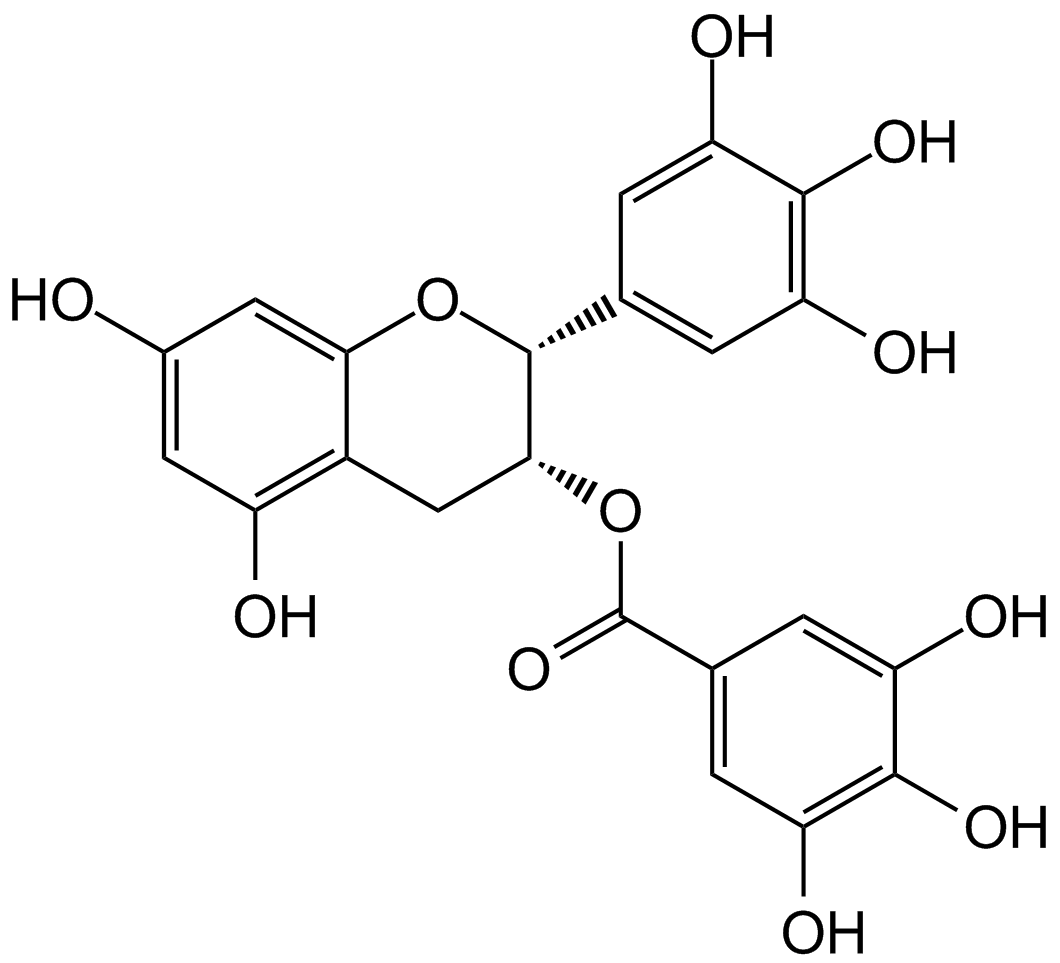
-
GC69463
(-)-GSK598809 hydrochloride
(1S,5R)-GSK598809 hydrochloride
(-)-GSK598809 is the enantiomer of GSK598809. GSK598809 is a selective antagonist of dopamine D3 receptor (DRD3).



